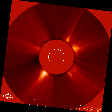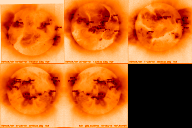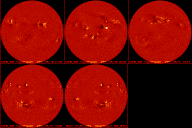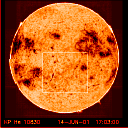 SoHO/LASCO C2 image on 7-June-2001 at 21:54UT.
SoHO/LASCO C2 image on 7-June-2001 at 21:54UT.
The first solar total eclipse in this millennium is approaching within two weeks. It will be seen on 21st June, 2001, from the area crossing southern Africa through Madagascar. You can find general information on this eclipse in several web sites; Fred Espenak's eclipse homepage may be one of the most popular. It is expected that quite a few people will visit the totality band for a mystical experience or for scientific purposes. For those people, especially those with scientific motivation, it is often helpful to know the global structure of the corona in advance, because this kind of information will allow an early decision regarding target region and other observational parameters.
Actually, there is some good predictive work already. For example, Mikic et al. have provided simulated images of the white light brightness and global magnetic structures of the corona based on the recent distribution of the photospheric magnetic field. For details, please visit their web site, http://haven.saic.com/corona/jun01eclipse/jun01eclipse.html. Even without numerical calculation, coronagraphic images from a half solar rotation (about 13.6 days) before the eclipse are also useful for the prediction of global structure. A figure below is an image taken with the SoHO/LASCO-C2 coronagraph at about a half rotation before the eclipse time. Note that the image is rotated a little clockwise (about 7 deg.) in order to match the view from the ground. Since global structures tend to have long life and often sustain a few rotations, the structures seen then on the eastern limb are likely to be seen on the western limb again on the eclipse day (and the west-side structures will appear as east-side structures).
 SoHO/LASCO C2 image on 7-June-2001 at 21:54UT.
SoHO/LASCO C2 image on 7-June-2001 at 21:54UT.
From those images, some observers who plan to take photographs of the global corona with a rectangular field of view may prepare to orient their cameras so as to cover the longer extent in the north-south rather than east-west direction. By contrast, for those who plan to observe small-scale structures such as active region loops and prominences, more detailed structure of the inner corona will be desirable. SXT is one of the best instruments for such kind of prediction, and this is the purpose of the present nugget.
Let us make a quick look at recent SXT images. A series of images below goes back to one and a quarter solar rotation before the eclipse (-1.25 rot.), and proceeds by a quarter-rotation until the latest accessible image, a half rotation (a quarter rotation, updated on 15-Jun) before eclipse day. Exact dates and times are as listed below, but selection of images assembled here are rather rough just for convenience. For reference, the images of photospheric magnetic fields observed with SoHO/MDI are also shown.
 Assembly of SXT images
Assembly of SXT images
 Assembly of MDI images
Assembly of MDI images
Note that the time of totality is chosen as 21-Jun-01, 13:10 UT, which nearly corresponds to the one at Lusaka in Zambia, and the Carrington longitudes and numbers are those of the central meridian (CM). The bottom two images are the same except that the middle is reversed with respect to the east-west direction. Thereby one can easily imagine the brightness distribution on the eclipse day. Furthermore, those images should be rotated clockwise, as done in the LASCO image above, for comparison with the ground-based observations, usually oriented in the local geographic north-south direction.
| relative rotation | time | Carrington longitude of CM | Carrington number | What we know from... |
| -1.25 | 18-May-01, 13:10 | 203.6 (deg) | 1976.43 | west limb structures passing CM |
| -1.0 | 25-May-01, 08:30 | 113.6 | 1976.68 | (quasi-) eclipse image |
| -0.75 | 1-Jun-01, 03:40 | 23.6 | 1976.93 | east limb structures passing CM |
| -0.5 | 7-Jun-01, 22:50 | 293.6 | 1977.18 | (quasi-) eclipse image, E-W reversed |
| -0.25 | 14-Jun-01, 18:00 | 203.6 | 1977.43 | west limb structures passing CM |
| 0 | 21-Jun-01 13:10 | 113.6 | 1977.68 | the eclipse day |
To look at the image of 1.25 rotation before the eclipse day is helpful in forecasting the structures seen on the western limb during the totality. This is because the structures on the central meridian are expected to have rotated to the western limb on the eclipse day. Naturally, the image of 0.25 rotation before is more helpful but it was not available yet at the time of this writing. According to the image above, the area around the central meridian is so far quiet, with no numbered active regions. AR 9454 observed in the 18-May image, a little west of the central meridian, seems to have grown up to an active region group, 9491, 9492, and 9493, in the 8-Jun image and this may contribute to the brightness on the western limb. However, since they will be significantly rotated away from the limb, we do not expect this to be a worthwhile target for studying loop systems.
Now, an image at -0.25 rotation has become available since 15-Jun. This image shows that a region, AR 9498, has appeared a little east of the central meridian. Unfortunately, this region looks not large and intensive enough, so it is still uncertain if it will be an interesing target. Rather, as seen in Helium 10830 image below, there are a few dark filaments located in the area a little (15 deg) south of the disk center. Some of these will be observable on the western limb as prominences.
 He10830 image at Kitt Peak Observatory, 14-jun-01
He10830 image at Kitt Peak Observatory, 14-jun-01
As far as looking at the 1-Jun image, AR 9475 is around the central meridian, and may reach to the eastern limb on the eclipse day. According to the corresponding MDI images, however, this region looks so diffuse that it may not keep its brightness. Rather, the newly emerged AR 9486 will be a promising target, if it continues to evolve.
A distinct coronal hole, which has long been located in the southern hemisphere (seen clearly in the 18-May and 25-May images) seems to be declining. The 8-Jun image show that now a definite hole is occupying the north pole and may contribute to decrease the brightness of the north polar region.
Based on the -0.25 rotation image, the body of the southern coronal hole described above is showing up again from the eastern limb. Although its slender arm having stretched toward equator during the last disk passage cannot be identified anymore, the main body remains to be distinct. Since this hole will probably reach to the south-west quadrant, it will contribute to decrease the brightness of the south polar region on the eclipse day.
In terms of the observations of active regions, the current configuration of active regions looks not so exciting. The most promising target is AR 9486 which will have returned to the northeast limb. If it evolves significantly while passing behind the disk, it may provide a good loop system to be observed. If a coronal hole is the target, larger and more distinct hole locates around north polar region, although now its main body is passing the invisible side of the disk. There is a hole near southern polar region, but it looks weaker than the northern one.
However, please keep in mind the fact that these predictions can easily go bad due to significant and rapid emergence of new magnetic flux. It might provide for observations that are unexpectedly exciting and fruitful. Good observations, to everyone!